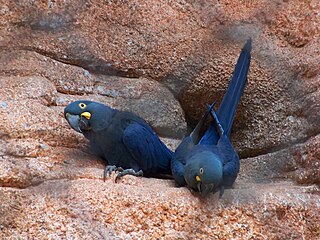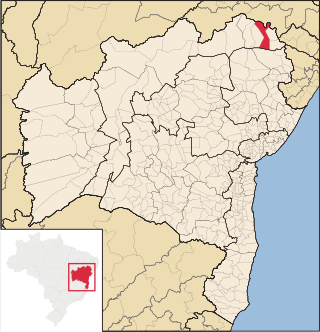Environment
The climate is semi-arid, the driest region of Bahia. Average temperatures are 27 °C (81 °F). Average annual rainfall is about 400 millimetres (16 in), falling unpredictably during a few days in the winter. Although there is a shortage of surface water, which is found only in the valleys of the São Francisco and Vaza-Barris rivers, there may be large underground reserves.
The whole area is covered by caatinga vegetation, consisting of cacti, palm trees, bromeliads and other xerophytic plants. Common species include the umbuzeiro, angico, aroeira, faveleira, catingueira and pau-de-rato. It is home to the Lear's macaw (Anodorhynchus leari), an endangered species that uses the sandstone cliffs of the Serra Branca as a breeding area. The macaws traditionally nest in two areas, the Toca Velha owned by the Fundação Biodiversitas in Canudos and the privately owned Fazenda Serra Branca in the APA. The main food of this bird is the nut of the Syagrus coronata (licuri palm), which grows in the APA.

Lear's macaw, also known as the indigo macaw, is a large all-blue Brazilian parrot, a member of a large group of neotropical parrots known as macaws. It was first described by Charles Lucien Bonaparte in 1856. Lear's macaw is 70–75 cm long and weighs around 950 g. It is coloured almost completely blue, with a yellow patch of skin at the base of the heavy, black bill.

The Vaza-Barris River is a river in northeastern Brazil. The Vaza-Barris originates in northeastern Bahia state, and flows east through Bahia and Sergipe states to empty into the Atlantic Ocean near São Cristóvão.

The Catimbau National Park is a national park in the state of Pernambuco, Brazil. It protects a semi-arid area of caatinga with sandstone caverns and caves in which prehistoric art has been found.
Serra Negra Biological Reserve is a Biological reserve in the state of Pernambuco, Brazil.
Raso da Catarina Ecological Station is a strictly protected ecological station in the state of Bahia in Brazil. It lies in the Raso da Catarina ecoregion of the Caatinga biome.

Jeremoabo is a municipality in the state of Bahia in the North-East region of Brazil.

Uruçuca is a municipality in the state of Bahia in the North-East region of Brazil.

Rodelas is a municipality in the state of Bahia in the North-East region of Brazil.
The Wenceslau Guimarães Ecological Station is an ecological station in the state of Bahia, Brazil.
The Caminhos Ecológicos da Boa Esperança Environmental Protection Area is an environmental protection area in the state of Bahia, Brazil.

The Lagoa Encantada e Rio Almada Environmental Protection Area is an environmental protection area in the state of Bahia, Brazil.

The Baía de Camamu Environmental Protection Area is an environmental protection area in the state of Bahia, Brazil. It tries to preserve the natural vegetation of mangroves, restinga and Atlantic Forest around the Camamu Bay.
The Caatinga Ecological Corridor is an ecological corridor in the caatinga biome of northeast Brazil.
The Lagoa do Frio Municipal Nature Park is a municipal nature park in the state of Sergipe, Brazil.
The Cocorobó Area of Relevant Ecological Interest is an area of relevant ecological interest in the state of Bahia, Brazil.
The Maurício Dantas Private Natural Heritage Ecological Reserve is a private natural heritage reserve in the state of Pernambuco, Brazil. It protects an area of dry caatinga vegetation. It was created on 12 September 1997.
The Cantidiano Valqueiro Barros Private Natural Heritage Reserve is a private natural heritage reserve in the state of Pernambuco, Brazil. It protects an area of dry caatinga vegetation.

The Raso da Catarina is an ecoregion in the caatinga biome of Bahia and Pernambuco, Brazil. It is a sandstone plateau, much eroded, that is extremely dry for most of the year. Vegetation includes low bushes, often thorny, cacti and bromeliads.

The Cocorobó Dam is a dam in the state of Bahia, Brazil. It provides a reservoir of water for irrigation and drinking in the arid caatinga environment of the Raso da Catarina. The reservoir covers the ruins of the city of Canudos, scene of the War of Canudos in 1896–97.

The Serra da Ibiapaba Environmental Protection Area is an environmental protection area in the states of Piauí and Ceará, Brazil. It contains fragments of cerrado, caatinga and Atlantic Forest, and is home to the endangered red-handed howler.
This page is based on this
Wikipedia article Text is available under the
CC BY-SA 4.0 license; additional terms may apply.
Images, videos and audio are available under their respective licenses.












